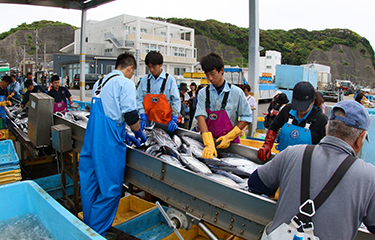Japan’s Fisheries Agency has released its annual Fisheries White Paper explaining trends and reviewing the policies of 2020, and setting forth new policies for 2021.
The situation of the marine products market in Japan and overseas was reviewed. Worldwide, the per-capita consumption of seafood has doubled in the last 50 years, and aquaculture production and marine products trade is rising, but domestically, consumption of seafood continues on a downward trend. Per-capita consumption of seafood in Japan is now below that of Norway and South Korea, while consumption levels in Indonesia and China are nearing that of Japan.
Domestic consumption of seafood amounted to about 7.24 million metric tons, with a self-sufficiency rate of 56 percent. Per-capita consumption of edible seafood was 23.8 kilograms. The most frequently consumed fresh seafood changed from squid and shrimp to salmon, tuna, and yellowtail, likely impacted by poor catches of squid, leading to high prices. Due to the spread of COVID-19, spending on eating out decreased and seafood purchases for home use increased. The value of marine product exports has also decreased significantly due to the pandemic.
In a survey, Japanese consumers who want to increase consumption cited seafood’s health advantages, while those who intend to eat less cited high prices and the labor of preparation. Regarding domestic supply, production volumes continue to decline, though the value has increased in recent years.
There is also increased consumer awareness of food safety and sustainable fisheries and aquaculture. The main eco-label programs in Japan come from the Marine Stewardship Council (MSC) and the Aquaculture Stewardship Council (ASC), and the domestic Marine Eco-Label (MEL). Ten fisheries in Japan are MSC-certified, with 300 processors and distributors holding chain-of-custody (CoC) certifications. For ASC, 13 operations at 68 locations hold approval, and 151 CoC’s have been certified under the program. For MEL, 7 fisheries and 41 aquaculture operations were certified. In addition to eco-labeling, the government is promoting regional branding and HACCP compliance to increase export opportunities.
One of the major topics in international fisheries was negotiations on eliminating fishery subsidies. Japan is concerned at the growth of China’s fleet, which is encouraged by subsidies. The country wants China to stop such subsidies, while also arguing some subsidies that Japan offers should still be allowed, such as assistance when fuel prices rise too much and below market financing of the fishery cooperatives.
Last year, an economic partnership agreement with the United Kingdom went into effect and Japan signed the RCEP multilateral trade agreement which includes China, ASEAN nations, Australia, and New Zealand.
Regarding polices for 2021, as the “Law for Partial Amendment of the Fisheries Law, etc.” came into effect in 2020 – which switches management of more species to a total allowable catch (TAC) rather than total allowable effort (TAE) – more and better stock estimates will be required. This will be done through expanded collection of landing information, employing more survey vessels, clarifying the relationship between the marine environment and resource fluctuations, and collecting operational and fishing ground environment information. As part of this effort, the fisheries agency will establish data policies and standardize data. Currently, while catch data must be reported, the format, particularly for electronic submission, is not strictly fixed. The aim is to manage 80 percent of species by TAC and shift these to individual quota system management by 2023.
Among several measures to monitor or improve the environment, the fisheries agency will support the development of a system of networked automatic observation devices to quickly and accurately report red tides and oxygen-deficient water that cause damage to coastal fisheries and aquaculture. This is especially important for bluefin tuna aquaculture, as tuna are more sensitive to oxygen deficiency than some other farm-raised fish like yellowtail and sea bream. Early notice of red tides would give farmers enough time to tow net pens to other areas.
There is a severe shortage of skilled fishery workers and marine engineers, so the agency is increasing efforts to promote these careers, while allowing marine qualification exams to be taken verbally instead of in writing. In addition, the training of foreign technical interns will be increased, and local fishery cooperatives are urged to smoothly incorporate skilled foreigners wishing to participate in local fisheries.
The government will also promote greater involvement of women in the fishery cooperatives. Currently, there are no women in leadership positions at local fishery cooperatives, and the government would like to encourage greater involvement. They are involved in processing and development of specialty products, and management of direct sales offices, and the Fisheries Agency will give additional support to these activities, such as through training.
Photo courtesy of Dane Gillett/Shutterstock







